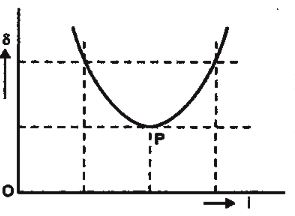In quantum mechanics, Heisenberg’s uncertainty principle is the most important principle, which states that it is very difficult or nearly impossible to measure more than one quantum variable (as it is defined by its wave function) simultaneously. This principle has been present in physics for a long time, making its importance too high. Theoretically, both the velocity and position of an object can not be measured simultaneously, which is what this principle implies.
This principle is contrary to Newtonian physics. The uncertainty principle evolved from the wave-particle duality, i.e. every particle has a wave related to it. The particle is observed at the place where the wave undulations are greatest. The more intense the undulations, the more ill-defined the wavelength becomes. As a result, the momentum of the particle is determined. This is the reason a strictly localized wave has an intermediate wavelength. The particle associated with such a wave will have a definite position but no definite velocity. Whereas a particle wave having a well-defined wave is spread out, the particle associated with such a wave will have precise velocity and may be present anywhere.
Heisenberg’s Uncertainty Principle: Definition
Heisenberg’s uncertainty principle, also called the indeterminacy principle, was given by German physicist Werner Heisenberg in 1927. It states that the velocity and position of an object can not be measured precisely or simultaneously, and that’s because exact velocity and exact position have no meaning in nature. This principle explains that simultaneous measurement of position and velocity of matter waves will always have an error.
Heisenberg’s Uncertainty Principle Formula
Assuming that ∆x is the error in the position measurement and ∆p is the measurement error of momentum then,
∆x × ∆p ≥ h/4π
Now momentum, p = mv
Heisenberg’s uncertainty formula can also be written as
∆x × ∆mv ≥ h/4π
where,
∆v is the measurement error of velocity assuming that the mass remains constant during the whole experiment,
∆x × ∆v ≥ h/4πm
The accurate measurement of position/momentum indicates a large error in the measurement of other quantities.
Application of Heisenberg’s principle on an electron in an orbit of the atom.
where h = 6.626 ×x10-34Js and m= 9.11 ×10-31Kg,
∆x × ∆v ≥ 6.626 × 10-34/4×3.14×9.11×10-31
= 10-4 m2 s-1.
If the position of an electron is subjected to be measured accurately to its size (10-10), then the error(in the measurement of velocity) would be nearly equal to 1000 kilometres.
The uncertainty principle is only applicable to dual-natured microscopic particles, not macroscopic particles.
Example of Heisenberg’s uncertainty principle
As we know, electromagnetic waves and matter particles exhibit dual nature, i.e. momentum/mass as well as wave nature.
Momentum and position of macroscopic nature can be easily and simultaneously identified with accuracy. For example, The speed and location of a moving automobile can be determined simultaneously at once with very low or a minimum error. Whereas in the case of microscopic particles, it would not be that easy to determine both the position and momentum simultaneously.
As an atom consists of electrons, electrons have an atomic mass of 9.91×10‐³¹ kg. So electrons are not visible by naked eyes. For that, we must require an illuminating source (as a source of light to identify and measure the electron’s position). At the time of identification, a collision of a powerful light source increases the momentum of the electron and makes it move away from the initial position. It means while fixing the position, the particle’s momentum would surely have changed from the original value.
Hence, in the case when a position is kept exact, the error occurs in the measurement of momentum or velocity.
Similarly, in the measurement of momentum, the error occurs in the position. So, in any case, either position or momentum/velocity can be measured accurately. So we can never measure both factors simultaneously.
Heisenberg’s Uncertainty Principle Equations
Heisenberg’s uncertainty principle can be written as
Equation 1: ∆X ⋅ ∆p ~ ħ
and Equation 2: ∆E ⋅ ∆t ~ ħ
Where,
∆X = is the uncertainty in the position
ħ = is the Planck’s constant
∆p = is the uncertainty in momentum
∆E = is the uncertainty in the energy
∆t = is the uncertainty in time measurement
Conclusion
The matter has a dual nature, and it has been observed that it poses the same interference characteristics as any other wave. As stated by Heisenberg’s uncertainty principle, we can not simultaneously determine two properties (i.e. position and velocity) of a wave. We will always get an error if we try to do so. The rule states that the product of uncertainties is equal to or greater than Planck’s constant represented by “h” or about 6.6×10-34 Joule per second. Uncertainties become significant only for the atoms and subatomic particles having extremely low masses.
A particle that has great vibrations becomes more indistinct. Particles with definite positions have no fixed velocity, and the well-defined wavelength particles have precise velocity. On the whole, if one gets an accurate reading of a quantity, it will lead to huge uncertainty in measuring other quantities.

Conclusion
Prism is a unique optical instrument showing us some tremendous optical phenomena. From breaking the white light into seven colours to the unrealistic bending of the incident ray, it has done nothing but amazed us.
 Profile
Profile Settings
Settings Refer your friends
Refer your friends Sign out
Sign out





